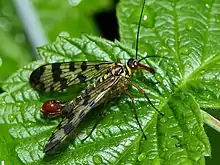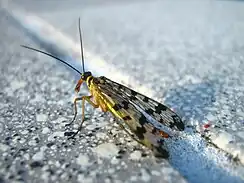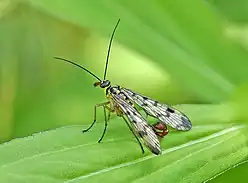| Panorpa vulgaris | |
|---|---|
 | |
| Scientific classification | |
| Domain: | Eukaryota |
| Kingdom: | Animalia |
| Phylum: | Arthropoda |
| Class: | Insecta |
| Order: | Mecoptera |
| Family: | Panorpidae |
| Genus: | Panorpa |
| Species: | P. vulgaris |
| Binomial name | |
| Panorpa vulgaris Imhoff & Labram, 1845 | |
Panorpa vulgaris, also known by its common name meadow scorpionfly is a species from the genus Panorpa.[1][2][3] The species was first described in 1845.[4]
Distribution and habitat
P. vulgaris are commonly distributed throughout central Europe.[5] They prefer dry and warm habitats that provide shade at high temperatures[6] and are most abundant along the edges of low-lying shrubs.[7] Despite their environmental preference, smaller populations do occur in forested areas that experience moist and cool conditions.[6]
Physiology
Vision
Meadow scorpionfly larvae have stemmata.[8] In adult individuals the cytoplasm of their neuron cells located within the eye become reduced with aging, resulting in decreased vision[9]
Flight
Adult individuals are often considered weak flyers[10] due to deterioration of tissues with increasing age.[9] Flight musculature degenerates over time due to the combination of deformed mitochondria and hypertrophy of connective tissues.[9]
Immunity
In early developmental stages larvae decrease their amount of hemocytes when transitioning into pupae.[11] This is hypothesized by the distribution of resources to reproductive structures.[11] Females are considered to have better immunity.[1] Females have higher amounts of hemocytes and increased lysosomal activity in their hemolymph compared to males.[1]


Nutrition
Individuals of both sexes are capable of foraging for food, they are heavily influenced by their environments.[12] Intraspecific and interspecific competition is common between and within both sexes when food sources are limited.[10] Both larvae and adults typically feed on dead arthropods, and adults are often kleptoparasites of spider webs.[10] Adults are generally capable of avoiding spiderwebs when feeding on prey.[10] Males will use their genital claspers and females will use their abdomens to remove prey from spider webs and will even strike spiders who attempt to interfere with them.[10]
Life cycle
The meadow scorpionfly develops two separate generations per year,[6] one generation that undergoes overwintering in early spring and another that experiences a diapause free-developing stage in the summer.[6][13] During their lifecycle individuals can survive up to two months.[14]][15]
Mating
Females meadow scorpionflies are known to be polyandrous, allowing them to make multiple mating attempts with numerous males.[16] Some females have shown evidence of being capable of mating with up to nine different males.[12][16] During mating, males will attach themselves to one of the females forewings with their genital claspers to remain connected until copulation is complete.[17] Male meadow scorpionflies provide nuptial gifts for their female counterparts.[12][10] The gifts males provide are a series of salivary secretions and different types of carrion that the females will ingest as a nutrient source.[10][16] In the males first generation salivary secretions are the main source of nuptial gifting.[10] During the second generation male salivary protein structures become depleted,[9] resulting in the use of carrion.[10] These nuptial gifts are both a mating effort and a form of paternal investment.[16] The duration of copulation between males and females is determined by the amount of saliva a male is able to produce.[12] While mating males will continuously transfer sperm to females until nuptial gifts are completely consumed.[16] The sperm transferred by males will eventually compete with other ejaculates from other males by the means of the raffle principle.[16] Since saliva production is a significant energy investment, it can be a quality indicator of male health.[15][12] Females will further discriminate between different males based on the amount of saliva provided.[12] The amount of saliva a female receives during mating directly influences the amount of offspring she is able to produce.[16] Males will also be selective of females based on the amount of offspring a female will be able to produce.[15][12][16] Inherently, males are capable of influencing the quality or the amount of ejaculate that they provide to females based on their bias.[12]
References
- 1 2 3 Joachim Kurtz; Wiesner A; Götz P; Sauer KP (1 January 2000). "Gender differences and individual variation in the immune system of the scorpionfly Panorpa vulgaris (Insecta: Mecoptera)". Developmental and Comparative Immunology. 24 (1): 1–12. doi:10.1016/S0145-305X(99)00057-9. ISSN 0145-305X. PMID 10689094. Wikidata Q52576756.
- ↑ Joachim Kurtz (1 June 2002). "Phagocytosis by invertebrate hemocytes: causes of individual variation in Panorpa vulgaris scorpionflies". Microscopy Research and Technique. 57 (6): 456–468. doi:10.1002/JEMT.10099. ISSN 1059-910X. PMID 12112428. Wikidata Q34733255.
- ↑ "Panorpa vulgaris". iNaturalist. Retrieved 2022-05-17.
- ↑ "Panorpa vulgaris Imhoff & Labram, 1845". www.gbif.org. Retrieved 2022-05-17.
- ↑ "Panorpa vulgaris Imhoff & Labram, 1845 | Fauna Europaea". fauna-eu.org. Retrieved 2022-12-16.
- 1 2 3 4 Kaltenbach, Alfred (1978). Handuch der Zoologie. W. de Gruyter. ISBN 3-11-007432-X. OCLC 468346800.
- ↑ Sauer, K. P.; Hensle, R. (April 1975). "Panorpa communis L. undPanorpa vulgaris Imhoff und Labram, zwei Arten". Experientia. 31 (4): 428–430. doi:10.1007/bf02026358. ISSN 0014-4754. PMID 1120506. S2CID 21175528 – via JSTOR.
- ↑ Melzer, Roland R. (1994-02-01). "Optic lobes of the larval and imaginal scorpionfly Panorpa vulgaris (Mecoptera, Panorpidae): A neuroanatomical study of neuropil organization, retinula axons, and lamina monopolar cells". Cell and Tissue Research. 275 (2): 283–290. doi:10.1007/BF00319426. ISSN 1432-0878. S2CID 35335056.
- 1 2 3 4 Collatz, K. -G.; Collatz, S. (1981-01-01). "Age dependent ultrastructural changes in different organs of the mecopteran fly Panorpa vulgaris". Experimental Gerontology. 16 (2): 183–193. doi:10.1016/0531-5565(81)90044-9. ISSN 0531-5565. PMID 7286097. S2CID 34952661.
- 1 2 3 4 5 6 7 8 9 Bockwinkel, G.; Sauer, K. P. (1993). Panorpa scorpionflies foraging in spider webs - kleptoparasitism at low risk.
- 1 2 Kurtz, Joachim (2002-06-15). "Phagocytosis by invertebrate hemocytes: Causes of individual variation inPanorpa vulgaris scorpionflies". Microscopy Research and Technique. 57 (6): 456–468. doi:10.1002/jemt.10099. ISSN 1059-910X. PMID 12112428. S2CID 24453198.
- 1 2 3 4 5 6 7 8 Missoweit, M.; Engels, S.; Sauer, K. P. (2007-01-01). "Foraging ability in the scorpionfly Panorpa vulgaris: individual differences and heritability". Behavioral Ecology and Sociobiology. 61 (3): 487–492. doi:10.1007/s00265-006-0277-y. ISSN 1432-0762. S2CID 7358938.
- ↑ Missoweit, Merle; Engqvist, Leif; Lubjuhn, Thomas; Sauer, Klaus Peter (2007-07-17). "Nuptial feeding in the scorpionfly Panorpa vulgaris: maintenance of genetic variance in sexual advertisement through dependence on condition influencing traits". Evolutionary Ecology. 22 (5): 689–699. doi:10.1007/s10682-007-9191-7. ISSN 0269-7653. S2CID 22358227.
- ↑ Thornhill, R (November 1981). "Panorpa (Mecoptera: Panorpidae) Scorpionflies: Systems for Understanding Resource-Defense Polygyny and Alternative Male Reproductive Efforts". Annual Review of Ecology and Systematics. 12 (1): 355–386. doi:10.1146/annurev.es.12.110181.002035. ISSN 0066-4162.
- 1 2 3 Sauer, Klaus Peter; Sindern, Jörn; Kall, Nicole (1997-01-01). "Nutritional Status of Males and Sperm Transfer in the Scorpionfly Panorpa vulgaris (Mecoptera: Panorpidae)". Entomologia Generalis: 189–204. doi:10.1127/entom.gen/21/1997/189.
- 1 2 3 4 5 6 7 8 Engels, Sierk; Sauer, Klaus Peter (2006-01-01). "Love for sale and its fitness benefits: nuptial gifts in the scorpionfly Panorpa vulgaris represent paternal investment". Behaviour. 143 (7): 825–837. doi:10.1163/156853906778017962. ISSN 0005-7959.
- ↑ Thornhill, Randy; Sauer, K. Peter (1991). "The notal organ of the scorpionfly (Panorpa vulgaris): an adaptation to coerce mating duration". Behavioral Ecology. 2 (2): 156–164. doi:10.1093/beheco/2.2.156. ISSN 1045-2249.